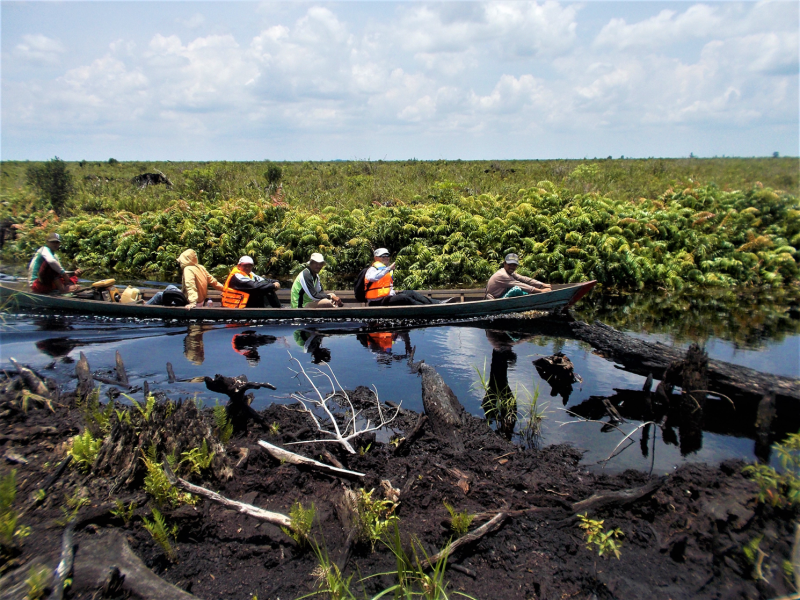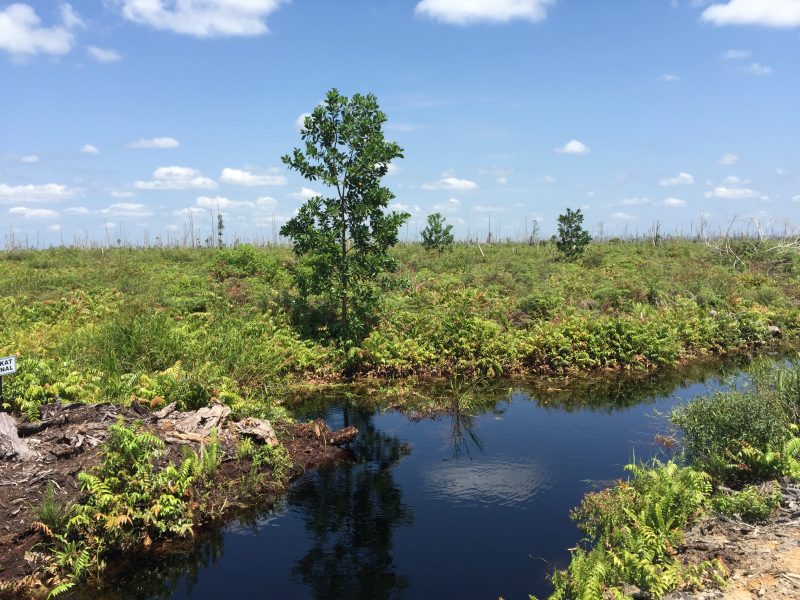
To extract timber and then convert wet peatlands, the peatlands must first be drained with canals, which also serve as transportation routes.
Integra
The science is clear: because of the changing climate, we’re seeing hotter days and drier conditions fueling longer and more severe wildfire seasons worldwide. A 2021 report from climate scientists at the Intergovernmental Panel on Climate Change (IPCC) found that dry, hot, and windy conditions that make it more likely for fires to take hold is a growing problem in many parts of the world and will become more common as the planet continues to warm.
Eight years ago, in the summer and fall of 2015, wildfires burned bright into the night on the Indonesian islands of Sumatra and Kalimantan. The fires caused more than 2.6 million hectares of peat swamp forests to burn, releasing tremendous amounts of greenhouse gases—an estimated 14-16 million tonnes of carbon dioxide (CO2), more than the daily emissions from the entire U.S. economy each day at their peak.
Thick smoke and haze from the Indonesian fires enveloped much of southeast Asia and led to an increase in haze-related illnesses, such as upper respiratory illnesses and acute conjunctivitis. According to a 2016 Harvard-Columbia University study, exposure to the haze from the wildfires caused more than 100,000 deaths across Indonesia, Malaysia, and Singapore.
These wildfires provided a dramatic illustration of the importance of sustainable peatland management in Indonesia and the importance of air quality.
From 2000 to 2010, over 2 million hectares of Indonesian peatland forest were cleared, deforested, and drained to make the land suitable for palm oil or marketable timber, making this land more susceptible to burning from fires. When burned, peat, which consists of partially decomposed plant material, contributes heavily to carbon emissions because of its high carbon content. In fact, it is estimated that peat forests store at least twice as much carbon as any other vegetation type.
To address this challenge, in 2016, the President of Indonesia established a Peatland Restoration Agency with the goal to rehabilitate 2.6 million hectares of drained and degraded peatlands in seven provinces across the country by the year 2020.
The Millennium Challenge Corporation (MCC) supported the Government of Indonesia’s priority by funding a $12.4 million portfolio of peatland related projects—two partnership grants, two support contracts, and one smaller community-based grant.
The peatland portfolio was part of MCC’s $228 million Green Prosperity Project (GPP), implemented from 2013-2018, which aimed to reduce land-based greenhouse gas emissions by improving land use practices and management of natural resources.
According to Martha Bowen, the Indonesia Country Director for MCC, the goal of MCC’s peatland portfolio was to support the Government of Indonesia’s own initiative to safeguard and restore the country’s rich peatland forests.
“When the Government of Indonesia established the Peatland Restoration Agency, we had a golden opportunity to put MCC’s principles of country ownership into practice,” she says.
“By making use of our existing program, we were able to quickly deploy funds for two types of peatland restoration projects: a community-based model and one that used heavy machinery to build dams. The two projects were designed to demonstrate two different approaches to restoring peatlands. The new Peatland Restoration Agency was able to compare these practices and learn valuable lessons, even while its own establishment was ongoing.”

view of cleared peatland with secondary vegetative regrowth and a drainage canal in the foreground. This was once heavily forested wetlands before being drained and logged.
Integra
Through the GPP investments, 253,559 hectares of peatland were mapped, and 232 dam structures were designed, constructed, and placed in canals to raise water levels with the aim to re-wet and restore peatland ecosystems, thereby reducing fire risk and greenhouse (GHG) emissions.
At the end of the GPP, preliminary modelling estimated potential greenhouse gas (GHG) emissions reductions from its 66 sub-projects to be approximately 1 million tonnes of carbon dioxide per year, with potential reductions from the peatland portfolio estimated at 300,000 tonnes of carbon dioxide per year, which is equivalent to removing 66,500 cars from American roads.
“Ultimately, our peatland restoration investments contributed approximately 30% of the estimated emissions reductions for the entire Green Prosperity Project, the second highest proportion,” says Bowen. “Looking at the GPP overall, 94% of the estimated emissions reductions came from natural resource management sub-projects, and only 6% from renewable energy investments.”
Globally, approximately 15% of the world’s known peatlands have been irreversibly damaged or are currently undergoing extreme degradation due to human activities. It is estimated that damaged peatlands worldwide emit at least 2 billion tons of carbon dioxide annually – roughly 5% of greenhouse gas emissions.
As the frequency and severity of wildfires increase worldwide, peatland wildfires are expected to be a growing problem and will likely accelerate the pace of global warming. Protecting and restoring the world’s peatland forests can therefore play a vital role in efforts to stabilize the climate.
For Sergio Feld, a Director of Environmental and Social Performance at MCC, the increase in the frequency of wildfires worldwide highlights the need for governments, NGOs, and international development agencies to invest in natural infrastructure solutions.
Natural infrastructure, in contrast to manmade infrastructure, refers to the use of naturally occurring landscape features and nature-based solutions that promote, use, restore, or emulate natural ecological processes. Estimates suggest that nature-based solutions can provide 37% of the mitigation needed until 2030 to achieve the targets of the Paris Agreement.
“MCC’s peatland portfolio highlights the need to continue to invest in natural infrastructure projects around the world,” says Feld. “In this case, we worked to restore peatlands in Indonesia so they can retain and absorb carbon. By re-wetting peatlands, we helped nature by providing an important ecosystem service.”
“Hopefully we will be doing more infrastructure projects with our partners around the world. We are going to do natural infrastructure projects in the Solomon Islands and in Mozambique. There are many engineering solutions that can help--– let's help nature do its healing work. ”

